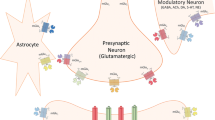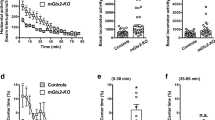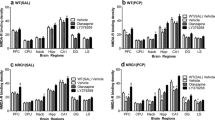Abstract
Rationale
Group II metabotropic glutamate receptors (mGluRs) comprise the mGluR2 and mGluR3 subtypes, the activation and modulation of which has been suggested to be beneficial for treating schizophrenia. Genetic association studies suggest limited association between mGluR2 and schizophrenia but some association between mGluR3 and schizophrenia. Conversely, pre-clinical studies suggest that mGluR2 may be responsible for mediating the antipsychotic activity of mGluR2/3 agonists, although to date, the role of mGluR3 has not been specifically assessed.
Objectives
The aim of this study is to use recently generated mGluR3 and mGluR2 knockout mice to investigate which of the group II mGluRs mediates the actions of the mGluR2/3 agonist, LY379268, in two mouse models predictive of antipsychotic activity.
Materials and methods
LY379268 (0.3–10 mg/kg SC), phencyclidine (PCP; 1–5 mg/kg IP), and amphetamine 1–10 mg/kg IP) were assessed on locomotor activity and behaviour in C57Bl/6J and transgenic mice. LY379268 was then assessed on PCP (5 mg/kg IP)- and amphetamine (2.5 mg/kg IP)-induced hyperactivity and behaviour in C57Bl/6J and transgenic mice.
Results
PCP (5 mg/kg)-evoked hyperactivity and behavioural alterations, i.e. circling, falling, stereotypy and ataxia, as well as amphetamine (2.5 mg/kg)-evoked hyperactivity, were dose-dependently attenuated by LY379268 (0.3–3 mg/kg) in C57Bl/6J mice. One milligram per kilogram of LY379268 reversed PCP-evoked hyperactivity and behavioural alterations in wild-type (WT) and mGluR3 knockout mice but not in mice lacking mGluR2. Similarly, 3 mg/kg LY379268 reversed amphetamine-evoked hyperactivity in WT and mGluR3 knockout mice but not in mice lacking mGluR2.
Conclusion
The mGlu2 but not the mGlu3 receptor subtype mediates the actions of the mGluR2/3 agonist, LY379268, in mouse models predictive of antipsychotic activity.




Similar content being viewed by others
References
Anwyl R (1999) Metabotropic glutamate receptors: electrophysiological properties and role in plasticity. Brains Res Rev 29:83–120
Bespalov A, Jongen-Relo A-L, van Gaalen M, Harich S, Schoemaker H, Gross G (2007) Habituation deficits induced by metabotropic glutamate receptors 2/3 receptor blockade in mice: reversal by antipsychotic drugs. J Pharmacol Exp Ther 320:1–7
Bulthuis RJA, Bergman AF, Nijessen S, Schlingmann F, Tolboom J, Remie R (1998) Automated behaviour classification: the Laborasä project. Proceedings of the Sixth FESLA symposium; harmonisation of laboratory animal husbandry, pp 17–18
Cartmell J, Schoepp DD (2000) Regulation of neurotransmitter release by metabotropic glutamate receptors. J Neurochem 75:889–907
Cartmell J, Monn JA, Schoepp DD (1999) The metabotropic glutamate 2/3 receptor agonists LY354740 and LY379268 selectively attenuate phencyclidine versus d-amphetamine motor behaviours in rats. J Pharmacol Exp Ther 291:161–170
Cartmell J, Monn JA, Schoepp DD (2000) The mGlu2/3 receptor agonists LY379268 selectively blocks amphetamine ambulations and rearing. Eur J Pharmacol 361:39–46
Chen Q, He G, Chen Q, Wu S, Xu Y, Feng G, Li Y, Wang L, He L (2005) A case-control study of the relationship between the metabotropic glutamate receptor 3 gene and schizophrenia in the Chinese population. Schizophr Res 73:21–226
Conn PJ, Pin JP (1997) Pharmacology and functions of metabotropic glutamate receptors. Annu Rev Pharmacol Toxicol 37:205–237
Corti C, Andreoli M, Marcon C, Zambon S, Heidbreder C, Mugnaini M (2004) Generation and characterisation of mGluR3 deficient mice in models of alcohol dependence. Society for Neuroscience, San Diego, p 234.215
Egan MF, Straub RE, Goldberg TE, Yakub I, Callicott JH, Hariri AR, Mattay VS, Bertolino A, Hyde TM, Shannon-Weickert C, Akil M, Crook J, Vakkalanka RK, Balkissoon R, Gibbs RA, Kleinman JE, Weinberger DR (2004) Variation in GRM3 affects cognition, prefrontal glutamate, and risk for schizophrenia. Proc Natl Acad Sci U S A 101:12604–12609
Fujii Y, Shibata H, Kikuta R, Makino C, Tani A, Hirata N, Shibata A, Ninomiya H, Tashiro N, Fukumaki Y (2003) Positive associations of polymorphisms in the metabotropic glutamate receptor type 3 gene (GRM3) with schizophrenia. Psychiatr Genet 13:71–76
Galici R, Echemendia NG, Rodriguez AL, Conn JP (2005) A selective allosteric potentiator of metabotropic glutamate (mGlu) 2 receptors has effects similar to an orthosteir mGlu2/3 receptor agonist in mouse models predictive of antipsychotic activity. J Pharmacol Exp Ther 315:1181–1187
Galici R, Jones CK, Hemstapat K, Nong Y, Echemendia NG, Williams LC, de Paulis T, Conn JP (2006) Biphenyl-indanone A, a positive allosteric modulator of the metabotropic glutamate receptor subtype 2, has antipsychotic- and anxiolytic-like effects in mice. J Pharmacol Exp Ther 318:173–185
Govek SP, Bonnefous C, Hutchinson JH, Kamenecka T, AcQuiston J, Pracitto R, Zhao LX, Gardner MF, James JK, Daggett LP, Rowe BA, Schaffhauser H, Bristow L, Campbell UC, Rodriguez DE, Vernier J-M (2005) Bioorg Med Chem Lett 15:4068–4072
Harrison PJ, Weinberger DR (2005) Schizophrenia genes, gene expression, and neuropathology: on the matter of their convergence. Mol Psychiatry 10:40–68
Hochberg Y (1988) A sharper Bonferroni procedure for multiple tests of significance. Biometrika 75:800–802
Imre G, Salomons A, Jongsma M, Fokkema DS, Den Boer JA, Ter Horst GJ (2006) Effects of the mGluR2/3 agonist LY379268 on ketamine-evoked behaviours and neurochemical changes in the dentate gyrus of the rat. Pharmacol Biochem Behav 84:392–399
Johnson MP, Barda D, Britton TC, Emkey R, Hornback WJ, Jagdmann GE, McKinzie DL, Nisenbaum ES, Tizzano JP, Schoepp DD (2005) Metabotropic glutamate 2 receptor potentiators: receptor modulation, frequency-dependent synaptic activity, and efficacy in preclinical anxiety and psychosis model(s). Psychopharmacology 179:271–283
Joo A, Shibata H, Ninomiya H, Kawasaki H, Tashiro N, Fukumaki Y (2001) Structure and polymorphisms of the human metabotropic glutamate receptor type 2 gene (GRM2): analysis of association with schizophrenia. Mol Psychiatry 6:186–192
Krystal JH, Abi-Saab W, Perry E, D’Souza DC, Liu N, Gueorguieva R, McDougall L, Hunsberger T, Belger A, Levine L, Breier A (2005) Preliminary evidence of attenuation of the disruptive effects of the NMDA glutamate receptor antagonist, ketamine, on working memory by pretreatment with the group II metabotropic glutamate receptor agonist, LY354740, in healthy human subjects. Psychopharmacology 179:303–309
Linden A-M, Baez M, Bergeron M, Schoepp DD (2006) Effects of mGlu2 or mGlu3 receptor deletions on mGlu2/3 receptor agonist (LY354740)-induced brain c-Fos expression: specific roles for mGlu2 in the amygdale and subcortical nuclei and mGlu3 in the hippocampus. Neuropharmacology 51:213–228
Lorrain DS, Schaffhauser H, Campbell UC, Baccei CS, Correa LD, Rowe B, Rodriguez DE, Anderson JJ, Varney MA, Pinkerton AB, Vernier J-M, Bristow L (2003) Group I ImGlu receptor activation suppresses norepinephrine release in the ventral hippocampus and locomotor responses to acute ketamine challenge. Neuropsychopharmacology 28:1622–1632
Marti SB, Cichon S, Propping P, Nothen M (2002) Metabotropic glutamate receptor 3 (GRM3) gene variation is not associated with schizophrenia or bipolar affective disorder in the German population. Am J Med Genet 114:46–50
Moghaddam B, Adams B (1998) Reversal of phencyclidine effects by a group II metabotropic glutamate receptor agonists in rats. Science 281:1349–1352
O’Neill MF, Heron-Maxwell CL, Monn J, Ornstein PL (2003) Agonists with selectivity for mGluR2/3 receptors induce and antagonist-reversible suppression of spontaneous locomotor activity in mice. J Psychopharmacol 17(Suppl):A72H4
Patil S, Zhang L, Martenyi F, Lowe S, Jackson KA, Andreev BV, Avedisova AS, Bardenstein LM, Gurovich IY, Morozova MA, Mosolov SN, Nesnanov NG, Reznik AM, Smulevich AB, Tochilov VA, Johnson BG, Monn JA, Schoepp DD (2007) Activation of mGlu2/3 receptors as a new approach to treat schizophrenia: a randomized phase 2 clinical trial. Nat Med 13:1102–1107
Pinkerton AB, Vernier J-M, Schaffhauser H, Rowe BA, Campbell UC, Rodriguez DA, Lorrain DS, Baccei CS, Daggett LP, Bristow LJ (2004) Phenyl-tetrazolyl acetophenones: discovery of positive allosteric potentiators for the metabotropic glutamate 2 receptor. J Med Chem 47:4595–4599
Pinkerton AB, Cube RV, Hutchinson JH, James JK, Gardner MF, Rowe BA, Schaffhauser H, Rodriguez DE, Campbell UC, Daggett LP, Vernier J-M (2005) Allosteric potentiators of the metabotropic glutamate receptor 2 (mGlu2). Part 3: identification and biological activity of indanone containing mGlu2 receptor potentiators. Bioorg Med Chem Lett 15:1565–1571
Quinn LP, Stean TO, Trail B, Duxon MS, Stratton SC, Billinton A, Upton N (2003) Laboras: initial pharmacological validation of a system allowing continuous monitoring of laboratory rodent behaviour. J Neurosci Methods 130:83–92
Sartorius LJ, Nagappan, G, Lipska BK, Ly B, Yoshitatsu S, Ren-Patterson R, Li Z, Weinberger DR, Harrison PJ (2006) Alternative splicing of human metabotropic glutamate receptor 3. J Neurochem 96:1139–1148
Schlingmann F, Van de Weerd HA, Baumans V (1998) A balance device for the analysis of behavioural patterns in the mouse. Anim Welf 7:77–88
Schoepp DD, Marek GJ (2002) Preclinical pharmacology of mGluR2/3 receptor agonists: novel agents for Schizophrenia? Curr Drug Targets CNS Neurol Disord 1:215–225
Spooren WPJM, Gasparini F, van der Putten H, Koller M, Nakanishi S, Kuhn R (2000) Lack of effect of LY314582 (a group 2 metabotropic glutamate receptor agonist) on phencyclidine-induced locomotor activity in metabotropic glutamate receptor 2 knockout mice. Eur J Pharmacol 397:R1–R2
Tamaru Y, Nomura S, Mizuno N, Shigemoto R (2001) Distribution of metabotropic glutamate receptor mGluR3 in the mouse CNS: differential location relative to pre- and postsynaptic sites. Neuroscience 106:481–503
Varty GB, Higgins GA (1995) Reversal of dizocilpine-induced disruption of pre-pulse inhibition of an acoustic startle by the 5-HT2 receptor antagonist, ketanserin. Eur J Pharmacol 287:201–205
Yokoi M, Kobayashi K, Manabe T, Takahashi T, Sakaguchi I, Katsuura G, Shigemoto R, Ohishi H, Nomura S, Nakamura K, Nakao K, Katsuki M, Nakanishi S (1996) Impairment of hippocampal mossy fibre LTD in mice lacking mGluR2. Science 273:645–647
Acknowledgement
The authors gratefully acknowledge Professor Nakanishi, Professor Watanabe and Professor Yokoi, Kyoto University, Japan, for supplying mGluR2 knockout mice breeding pairs.
Author information
Authors and Affiliations
Corresponding author
Rights and permissions
About this article
Cite this article
Woolley, M.L., Pemberton, D.J., Bate, S. et al. The mGlu2 but not the mGlu3 receptor mediates the actions of the mGluR2/3 agonist, LY379268, in mouse models predictive of antipsychotic activity. Psychopharmacology 196, 431–440 (2008). https://doi.org/10.1007/s00213-007-0974-x
Received:
Accepted:
Published:
Issue Date:
DOI: https://doi.org/10.1007/s00213-007-0974-x




